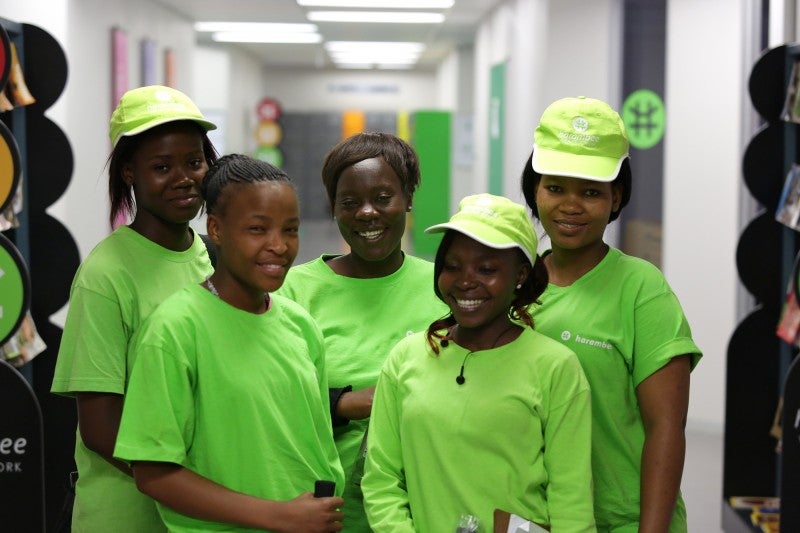
(Photo Credit: Harambee Youth Employment Accelerator)
Nicola Galombik is executive director of Yellowwoods and an Aspen Global Leadership Network Fellow (AGLN). She is one of four 2015 McNulty Prize Laureates. Below, Galombik explains how her AGLN leadership project is helping South African youth find work in a tough job market.
If young South Africans get and keep their first jobs, they have a high probability of staying employed for the rest of their lives. But getting that first job is the privilege of a few. One in every two South African young people is unemployed and at risk for long-term exclusion from actively participating in the country’s economy. While the shifting structures of the global economy, the ‘rise of the robots,’ and the deepening gulf of inequality take hold, the challenges faced in South Africa are examples of what’s happening in economies around the world, both developing and developed.
South Africa’s economy, like many others, includes plenty of open entry-level jobs. Yet those positions often remain unfilled, or are characterized by high turnover rates. And young people, especially those from poor families, find themselves locked out of the job market — because they don’t have social networks to link them into opportunities, money for or access to transportation and data connectivity, and because of education deficits — most often around their spoken English and math abilities. Thus, employers say they can’t find the work-ready talent they need, and avoid employing young, first-time work-seekers.
So what does it take to tackle youth unemployment on a large scale, and break the cycle of poverty, exclusion, and inequality it perpetuates?
In 2011, driven by our own business commitment to inclusive economic growth, we worked together with several of the businesses we’re invested in to catalyze an initiative to tackle the problem on a large scale. Through the Harambee Youth Employment Accelerator, we are finding solutions and making change happen across the labor market.
Today, Harambee has more than 300,000 young people in its network, and more than 200 employer-partners. Harambee has also partnered with the government and other donors, and together we’re finding breakthrough solutions to intractable problems.
To change the unemployment numbers for young people in South Africa, we need a combination of innovative JobTech solutions, built off data-rich systems and insights, as well as sustained and vigorous engagement with different social actors, including employers, young work-seekers, and government. Instead of determining young people’s job readiness based solely on their qualifications or work experience, Harambee’s data-rich matching platforms assess young people’s employment potential and match them with jobs using new proxies based on personality, competence, and behavioral and functional readiness as indicators for their likelihood of success.
Through this innovation, we’re starting to challenge qualifications frameworks that are often barriers to inclusion rather than enablers. Education systems have been slow to respond to changing markets and economic realities — and there is a significant lag in shifting this way of thinking. When it comes to entry-level positions, employers most often say they value behavioral and problem-solving capabilities more than content knowledge. Yet, employers continue to use assessments and entry requirements that are based on current qualifications frameworks that value content and length of study over other markers of readiness.
Our partnerships and servicing solutions for employers deliver real value for businesses, reducing their costs of recruitment, enhancing their access to new talent pools, and improving retention and progression potential.
Through our close relationships with employers — large and small — across the country, Harambee is starting to shift employer mindsets and their willingness to see young first-timers as assets rather than as risks to be managed. We’re starting to contribute to and influence government policy and interventions — such as access to public transportation and work-readiness programs — which are key to young people’s prospects of finding and keeping a job.
Using mobile and blended learning solutions, we’re able to work with young people to increase their employability and to link them to job opportunities and/or further education pathways. Through these methods we’ve been able to engage with youth about their career aspirations, motivations, and choices, and to direct their efforts toward a productive future.
At the city level, through an exciting initiative with the City of Johannesburg, we’re developing a “clearing house” for young work-seekers to provide a pathway to link them to work, entrepreneurial, and educational opportunities. We’re also growing the pool of work-ready young people for burgeoning economic sectors such as business process outsourcing, information and communications technology, and manufacturing.
If we can make this shift in the economic ecosystem work — to positively engage young people and change the mindsets and practices of employers — we can shift the most important currency for this generation of young people — hope.

